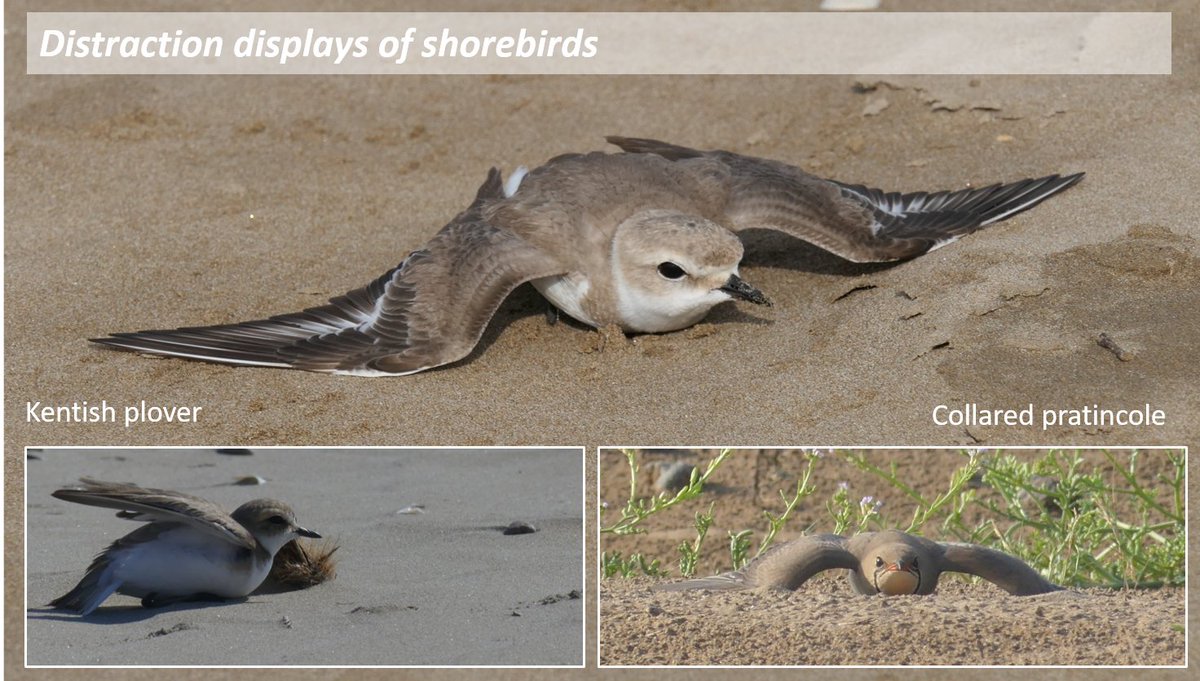Human activities have an impact on breeding shorebirds (waders) http://ow.ly/NGQ150BpSvF But 
Can we assess whether we are disturbing birds?
Yeah! These species often perform distracting behaviors to keep intruders away from the nest. Thread 1 / 13
1 / 13
#ornithology @britishbirds

Can we assess whether we are disturbing birds?
Yeah! These species often perform distracting behaviors to keep intruders away from the nest. Thread
 1 / 13
1 / 13#ornithology @britishbirds
Distracting behavior involves a bird pretending to be injured to draw the predator's attention to itself. This behavior ends when the bird removes the intruder from the nest or chicks https://academic.oup.com/beheco/article/28/1/260/2453523#.X9Nx9kkHRhw.twitter 2/13
http://ow.ly/NGQ150BpSvF @_BTO @nature_org
http://ow.ly/NGQ150BpSvF @_BTO @nature_org
Nest defense usually begins with vocalizations to get the predator's attention. If the predator is deceived, it will be enough to emit these calls to keep it away from the offspring https://doi.org/10.1093/beheco/arw157
In the video a Little ringed plover calling your attention 3/13
In the video a Little ringed plover calling your attention 3/13
There are different types of distraction displays http://ow.ly/2h7e306ok1s The most famous is called “The broken-wing display". The bird pretends to have an injury that prevents it from flying. Easy prey? 
 https://doi.org/10.1007/978-3-319-47829-6_2007-2 4/13
https://doi.org/10.1007/978-3-319-47829-6_2007-2 4/13

 https://doi.org/10.1007/978-3-319-47829-6_2007-2 4/13
https://doi.org/10.1007/978-3-319-47829-6_2007-2 4/13
Other distracting displays (e.g. rodent-run display) consist of the birds pretending to be a terrestrial prey, such as a small mammal. As they do not fly, it may seem like an easier prey
https://academic.oup.com/beheco/article/28/1/260/2453523#.X9Nx9kkHRhw.twitter 5/13
https://academic.oup.com/beheco/article/28/1/260/2453523#.X9Nx9kkHRhw.twitter 5/13
It is also common for some birds to pretend to incubate false nests, to attract the predator's attention to non-existent eggs or chicks. Of course, this false nest is far from the true one. https://academic.oup.com/beheco/article/28/1/260/2453523#.X9Nx9kkHRhw.twitter 6/13
When neither strategy works, birds can perform riskier behaviors, such as pretending to be exhausted very close to the predator. Birds may remain motionless while keeping wings extended as if exhausted or shuffle wings rhythmically or spasmodically https://academic.oup.com/beheco/article/28/1/260/2453523#.X9Nx9kkHRhw.twitter 7/13
Obviously, these defense strategies work and evolution has maintained them. It has been shown that nests of Kentish Plovers couples who risk more with these distraction displays survive longer: https://academic.oup.com/beheco/article/28/1/260/2453523#.X9Nx9kkHRhw.twitter 8/13
In addiction, it has been seen that there is a gender bias in this defensive behavior. Although both sexes incubate, females take more risks in their distraction displays, consistent with their greater investment in reproduction https://academic.oup.com/beheco/article/28/1/260/2453523#.X9Nx9kkHRhw.twitter 9/13
The problem is that birds consider people as potential predators https://doi.org/10.1371/journal.pone.0107121, even if they don't chase them. But the anti-predatory stimulus is even greater in the case of dogs, which cause birds to flee more frequently.
http://ow.ly/NGQ150BpSvF 10/13
http://ow.ly/NGQ150BpSvF 10/13
Interestingly, birds are able to habituated to human disturbance, thus reducing their stress. In this way they can flee to shorter distances from people or return faster to the nest once disturbance ends.
But the same does not happen with dogs
the same does not happen with dogs  http://ow.ly/NGQ150BpSvF 11/13
http://ow.ly/NGQ150BpSvF 11/13
But
 the same does not happen with dogs
the same does not happen with dogs  http://ow.ly/NGQ150BpSvF 11/13
http://ow.ly/NGQ150BpSvF 11/13
This video shows a summary of the distracting displays that Kentish Plovers do when someone is near their nest. https://academic.oup.com/beheco/article/28/1/260/2453523#.X9Nx9kkHRhw.twitter
https://doi.org/10.1371/journal.pone.0107121 12/13
https://doi.org/10.1371/journal.pone.0107121 12/13

 If you see these distraction displays during the breeding season, it is because you are too close to a nest. Get away as soon as possible and avoid walking unleashed dogs where you see bird activity
If you see these distraction displays during the breeding season, it is because you are too close to a nest. Get away as soon as possible and avoid walking unleashed dogs where you see bird activity  http://ow.ly/NGQ150BpSvF
http://ow.ly/NGQ150BpSvF https://doi.org/10.1371/journal.pone.0107121 13/13

 Read on Twitter
Read on Twitter













